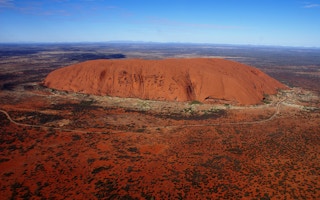Climate change could ruin the beaches, national parks and other natural attractions that prop up the Australian tourism sector, a new report by non-profit advocacy group Climate Council shows.
To continue reading, subscribe to Eco‑Business.
There's something for everyone. We offer a range of subscription plans.
- Access our stories and receive our Insights Weekly newsletter with the free EB Member plan.
- Unlock unlimited access to our content and archive with EB Circle.
- Publish your content with EB Premium.
Released on Wednesday and titled ‘Icons at risk: Climate change threatening Australian tourism‘, the report says that nature-based tourist destinations such as beaches, wildlife, the Great Barrier Reef, national parks, and the wilderness—which account for the top five attractions in Australia according to visitor surveys—could lose their appeal thanks to the effects of climate change.
Extreme heatwaves, rising sea levels, coastal flooding, and extensive coral bleaching are a few of the climate impacts that can make the tourist hotspots less appealing to visitors, said the report.
Lesley Hughes, climate councillor and ecologist, said in a statement: “In 2016 alone, more than 8 million international visitors arrived on our shores to see our natural icons, bringing in more than A$40 billion (US$31.3 billion).” Overall, tourism provides about 580,000 jobs in Australia, accounting for about five per cent of the country’s workforce.
“Climate change is placing one of Australia’s most valuable and fastest growing sectors under threat,” Hughes added.
Australia’s beaches, for instance, are its most popular tourist destination. But climate projections show that coastal flooding events are likely to become 100 times more frequent in cities such as Sydney, Melbourne, Hobart, Cairns, Darwin, Fremantle, and Adelaide. Sea levels are also project to rise by half a metre.
A 2013 survey of tourists about how they would respond to beach damage showed that between 17 and 23 per cent of them would switch destinations, said the Climate Council report. Such a trend would cause a A$56 million loss for the Sunshine Coast in Queensland and a $20 million loss for the Surf Coast in Victoria, every year.
Climate and conservation advocates have also sounded an alarm about the impact that coral bleaching in the Great Barrier Reef could have on the region’s tourism economy in the long run. Bleaching is the process whereby microscopic algae living on corals leave the organisms due to heat or pollution-induced stress; and if it occurs too frequently for corals to recover, they eventually die.
“
The current government’s priority focus on coal industry protection and company tax cuts is way off the mark and represents a flagrant disregard for the needs of all Australians.
Liz Hanna, honorary fellow of the Fenner School of Environment and Society, Australian National University,
The Great Barrier Reef underwent two back-to-back bleaching events in the summer months of 2016 and 2017, and scientists have predicted that another round of bleaching could occur this year. According to Climate Council estimates, the death of the reef could cause the loss of more than 1 million visitors every year. This would equate to a loss of at least A$1 billion in tourism spending, and 10,000 jobs.
Further inland, the ‘Red Centre’—the desert region in the centre of the continent, home to iconic attractions such as Uluru—would see the number of days where the daily average temperature rises above 30 degrees Celsius climb from 81 today to 100 in 2030; and 160 by 2090.
Inhospitable temperatures are not the only threat to Australia’s tourist hotspots. Research shows that as ocean temperatures rise and oceans remain at tropical temperatures for more months of the year, run-ins with the deadly irukandji jellyfish are likely to increase along Australia’s eastern coast. The fish thrive in warm water, and the season when they are active has been lengthening since the 1960s. They are also being spotted further south than they were previously.
Martin Rice, acting chief executive officer, Climate Council, said that while states, local governments, and tourism operators were taking a variety of measures to prevent ecosystem damage and reduce pollution, these efforts would amount to little without action from the Federal government.
For instance, businesses such as diving instructor operators Padi have become carbon neutral in a bid to reduce their contribution to climate change, while the Ayers Rock Resort at Uluru draws 15 per cent of its energy from solar power to reduce its reliance on fossil fuels.
However, “without credible climate policy that cuts Australia’s rising carbon pollution levels, the impacts of climate change will only intensify and accelerate across the country over the coming decades,” said Rice.
“For the sake of our iconic attractions, we just need the Federal Government to do the same.”
Academic experts said the report was “on the money”.
Liz Hanna, honorary fellow of the Fenner School of Environment and Society at the Australian National University, noted that tourism employs 15 Australians for every one person the coal industry hires.
“Tourism is under threat from climate change – so it needs protecting, and that means putting an immediate halt to policies that worsen climate change,” she said.
She added: “Protecting the tourism industry protects jobs and protects Australia’s economic wellbeing. The current government’s priority focus on coal industry protection and company tax cuts is way off the mark and represents a flagrant disregard for the needs of all Australians.”










